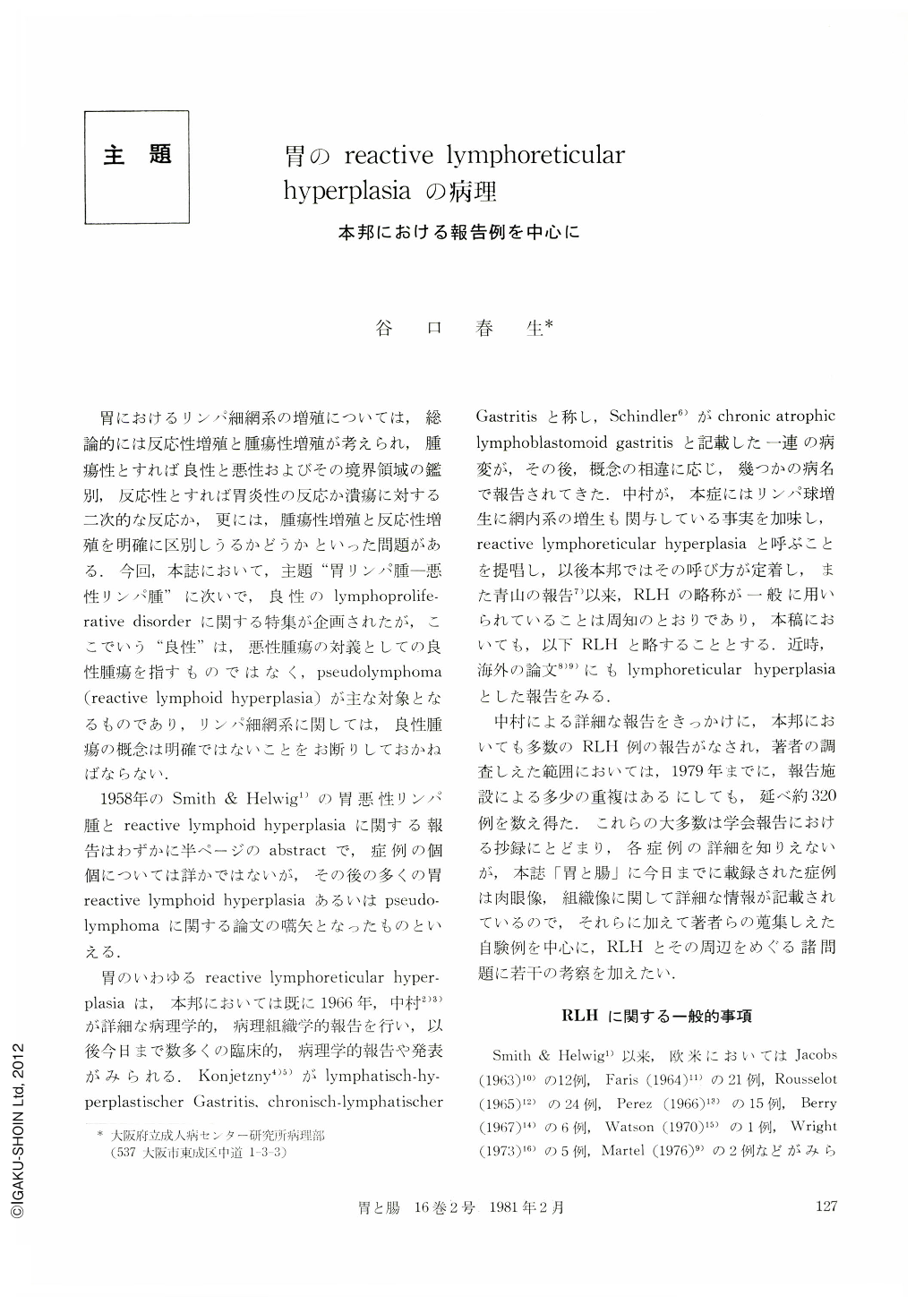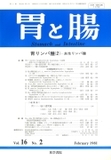Japanese
English
- 有料閲覧
- Abstract 文献概要
- 1ページ目 Look Inside
胃におけるリンパ細網系の増殖については,総論的には反応性増殖と腫瘍性増殖が考えられ,腫瘍性とすれば良性と悪性およびその境界領域の鑑別,反応性とすれば胃炎性の反応か潰瘍に対する二次的な反応か,更には,腫瘍性増殖と反応性増殖を明確に区別しうるかどうかといった問題がある.今回,本誌において,主題“胃リンパ腫―悪性リンパ腫”に次いで,良性のlymphoproliferative disorderに関する特集が企画されたが,ここでいう“良性”は,悪性腫瘍の対義としての良性腫瘍を指すものではなく,pseudolymphoma(reactive lymphoid hyperplasia)が主な対象となるものであり,リンパ細網系に関しては,良性腫瘍の概念は明確ではないことをお断りしておかねばならない.
1958年のSmith&Helwig1)の胃悪性リンパ腫とreactive lymphoid hyperplasiaに関する報告はわずかに半ページのabstractで,症例の個個については詳かではないが,その後の多くの胃reactive lymphoid hyperplasiaあるいはpseudolymphomaに関する論文の嚆矢となったものといえる.
In 1958, Smith and Helwig pointed out the confusion of histological diagnosis of malignant lymphoma of the stomach. Not only did they find too many cases of long surviving patients with gastric malignant lymphoma, but also difficulty in the differential diagnosis from reactive lymphoid hyperplasia, histologically.
In their conclusive reports, Helwig suggested the following as criteria: polymorphous cellular infiltrate, presence of reaction center and fibroblastic reaction for the histological diagnosis of this kind of pseudolymphoma. Thereafter, many cases of reactive lymphoid hyperplasia or pseudolymphoma have been reported in America and Continent by Jacobs, Faris, Rousselct, etc. In Japan, since Nakamura reported six cases of reactive lymphoreticular proliferative disorder and proposed to name it reactive lymphoreticular hyperplasia in 1966. RLH as its abbreviation became common and now, the number of case reports of RLH reach over 320. Nakamura classified it roughly into two, that of localized hypertrophic form and of diffuse flat form.
The review of 40 cases in this paper was made by adding seven cases of my experience to 33 cases which had been reported so far in “Stomach and Intestine”. In these 40 cases, those classified into localized hypertrophic form were 18 cases with mucosal hypertrophy like gyrus or localized hypertrophy of converging folds, and 13 of them were accompanied with ulcer. Their histological characteristics were proliferation of lymph follicles with reaction center accompanied by infiltration of plasma cell and scarred fibrosis. Surface of the swollen folds with rough nodules showed cobblestone appearance in some cases. As the special pattern of localized hypertrophic form, reactive lesion of submucosal tumor type was seen in three cases. In 17 cases of diffuse flat form, the lesions ranged all in the antrum. The major pattern of this form (12 cases) was widely spread erosion from angle to antrum with ulcers and the scars in it. These ulcers were all small for the wide lesion, and was interpreted as secondary ulcers which occured in gastric RLH. Three other cases of this form showed characteristic pattern of zonally spread lesions along the border between fundic and pyloric area with lineal ulceration. The remaining five cases were ulcerative type which did not belong to either of the two categories. This type was characteristic of deep ulcer with minimal change of marginal mucosa, but with reaction of RLH, unusually from the bottom to the edge of the ulcer histologically.
According to Mori's report, among 18 cases diagnosed histologically as RLH of the stomach, three gave monospecific reaction of immunoglobulin by the immuno-peroxydase method, and was interpreted as malignant lymphoma of B-cell type. Therefore it is necessary to re-examine the previous case of RLH by using the method of proving some markers like this, and to reconsider the criteria of the histo-morphological diagnosis on RLH by resulting consequent retrospective studies.

Copyright © 1981, Igaku-Shoin Ltd. All rights reserved.


